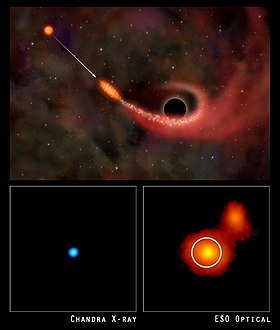Supermassive black hole

A supermassive black hole is a black hole with a mass in the range of millions or billions solar masses.
A supermassive black hole has some interesting properties differing from its low-mass cousins:
- The average density of a supermassive black hole can be very low, and actually can be lower than the density of water. This happens because the black hole radius increases linearly with mass, and consequently density drops much faster.
- Strong tidal forces are absent in the vicinity of the event horizon. Since the central singularity is so far away from the horizon, a hypothetical astronaut travelling towards the black hole center would not experience significant tidal force until very deep into the black hole.
Black holes of this size can only form in two ways: by slow accretion of matter (starting from a stellar size), or directly from external pressure in the first instants of Big Bang. The first method requires a long time and large amounts of matter available for the black hole growth.
Most if not all galaxies are thought to host a supermassive black hole in their center. Direct Doppler measures of the matter surrounding the nucleus of nearby galaxies have revealed a very fast motion, only possible with a high concentration of matter in the center. Currently, the only known object that can pack enough matter in such a small space is a black hole. For active galaxies farther away, the width of broad spectral lines is thought to be related to the mass of the black hole that powers the active galaxy's engine.
Such supermassive black holes in the center of many galaxies are thought to be the "engine" of active objects such as seyfert galaxies and quasars. Sagittarius A* is believed to be the supermassive black hole residing at the center of the Milky Way.
In May 2004, Paolo Padovani and other leading astronomers announced their discovery of 30 previously hidden supermassive black holes. Their discovery also suggests there at least twice as many of these black holes as previously thought.
See also
- black hole, a general survey
Classifification of black holes by type:
- Schwarzschild or static black hole
- rotating or Kerr black hole
- charged black hole or Newman black hole and Kerr-Newman black hole
Classification of black holes by mass:
- micro black hole and extra-dimensional black hole
- primordial black hole, a hypothetical leftover of the Big Bang
- stellar black hole, which could either be a static black hole or a rotating black hole
- supermassive black hole, which could also either be a static black hole or a rotating black hole